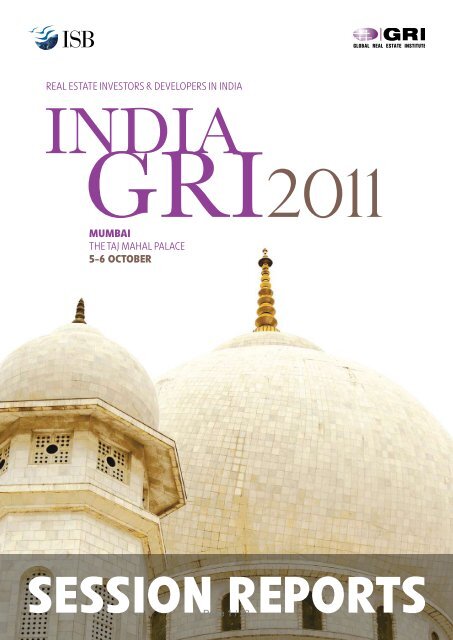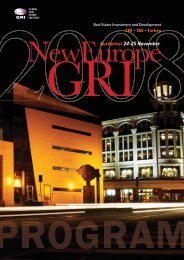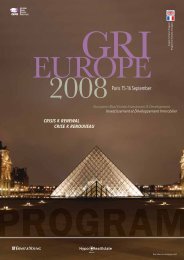SESSION REPORTS - Global Real Estate Institute
SESSION REPORTS - Global Real Estate Institute
SESSION REPORTS - Global Real Estate Institute
- No tags were found...
Create successful ePaper yourself
Turn your PDF publications into a flip-book with our unique Google optimized e-Paper software.
REAL ESTATE INVESTORS & DEVELOPERS IN INDIAINDIAGRI2011MUMBAITHE TAJ MAHAL PALACE5-6 OCTOBER<strong>SESSION</strong> <strong>REPORTS</strong>Page 1 / 23
CONTENTS PAGEIndian <strong>Real</strong> <strong>Estate</strong> - moving towards transparency and accountability? Page 3Value Creation – does private equity create superior returns? Page 4 – 5Mezzanine and Preferred Returns Financing - New mantra in private equity? Page 6Hotel Investment - Slowing down or just a breather? Page 7Office <strong>Real</strong> <strong>Estate</strong> - does demand-supply disparity create opportunities or problems? Page 8-9SEZ & CRZ - too regulated for their own good? Page 10Eastern India - worth a look or off the radar? Page 11Providing Debt – are lenders rushing in? Page 12Emerging Cities – Which Tier II and Tier III cities hold the shine? Page 13Professional Development Expertise - important, but where to get it from? Page 14Opportunities in India - Where to allocate your money? Page 15Hospitality <strong>Real</strong> <strong>Estate</strong> - new trends or old expectations? Page 16<strong>Real</strong> <strong>Estate</strong> Funds – main source of cash? Page 17Commercial <strong>Real</strong> <strong>Estate</strong> - are the returns there to be made? Page 18Slum Rehab & Redevelopments - Private Equity participation and risks involved Page 19Deal Restructuring – everyone a winner or who is losing? Page 20Foreign Investment - what JV structures work best? Page 21Residential <strong>Real</strong> <strong>Estate</strong> - stronghold in the downswing? Page 22<strong>Real</strong> <strong>Estate</strong> Acquisitions – how to manage pricing discipline and investment risks? Page 23
they do the role of providing funds to a developer in order to ensure timely completion of projects. However, theypointed out that this itself was a value since the absence of this we will be looking at a vast array of projects that will bediscontinued because of lack of capital.Mr. Uday Khemka, Sun Group, talked about how long term relationships with developers not only help in developing abetter understanding with the developer promoter but also over time can lead to generation of superior returns both forthe PE funds and the developer themselves. He mentioned that in his fund they attempt to forge long term relationshipswith the promoter. The rift and uncertainty related to returns on one particular project this way is done away with becauseas you develop better working relationship with the developer you do projects which earn you superior returns and alsoovertime the trust of the developer.Mr. Rishi Tej, mentioned that timing of the investment is also crucial for gaining superior returns. Talking on corporategovernance standards of the Indian real estate companies, the panel agreed that unlike markets internationally, in Indialisting of a company is not a necessary condition for high standards of corporate governance. The PE community present[fsi st[t_^ tb[t tb_ ^_\[t_ ih a_h_r[tcha suj_rcir r_turhs ][h’t \_ stu^c_s [s wbif_ [h^ h__^s ti \_ \rie_h ^iwh ti [debate for different sub-segments.While giving their concluding remarks members of the PE community did accept the fact that their main purpose was toreturn superior returns of their shareholders which will the LPs of the fund. As long as they are able to do that theyshould be happy. Whether these high returns result in the real estate company superior returns is a function of promotionrelationship, timing of investment and other factors.Page 4 / 23
TopicTimeVenueAttended by:Mezzanine and Preferred Returns Financing - New mantra in privateequity?14h30 - 15h45Golden Room, Taj Mahal Palace1) Anuj Malik, Arch Capital Management2) Ashish Singh, Standard Chartered3) Sunil Munot, ICICI Prudential4) Rohith Bhandary, ICICI Venture FundsThe discussion largely revolved around the panic caused in the investor community due to the recent policy amendmentthat restricts issuance of any kind of options – call/put or ROFR/ROFO in any contractual agreement between a FDI fundand an Indian company/promoter. This raises several pertinent issues concerning investment exit and structuredtransactions.Indian PERE market evolved from pure equity transactions to mezzanine and preferred return financing. The preferredreturn transactions took the most common valuation disagreement issue between the developer and the FDI fund off thetable. Several investors burnt their fingers during the 2006-08 when the real estate prices rose sharply and several dealswere concluded at fairly high valuations. So investors became more cautious and thus shifted towards protectedstructures. Information asymmetry towards developers enabled return protected structures. As a result, several deals gotconcluded.But due to recent policy amendment, it will be difficult to close such preferred return deals. In such cases, the funds willhave to adopt a pure play equity model and may struggle with reaching consensus on valuation. This will definitelyimpact the availability of capital for developers particularly those in tier 2 cities. Larger thrust will be on local rupeecapital that will be in high demand and may become a game changer now.A move towards pure play equity model will force investors to start taking higher risks (especially approval risks) andappropriately price them. The investors are definitely expected to understand the complex approval process intimately tobe able to price its risk.At the end the group concluded that the mezzanine and preferred returns financing is not a new mantra in private equity.Page 5 / 23
TopicHotel Investment- slowing down or just a breatherTime 14:30-15:45VenueEmerald & Jade, The Taj Mahal Palace, MumbaiAttended by:1) Kaushik Vardharajan, Managing Director, HVS2)Uttam Dave, President & CEO, Interglobe Hotels3) Siddharth Killekar, National Director- Capital markets groups, BNP Paribas<strong>Real</strong> <strong>Estate</strong> & Infrastructure Advisory Services4)Lokesh Kumar, Vice President- Development & marketing, Movenpick Hotels& Resorts Management5)Rajesh Punjabi, VP Development- India, Hilton WorldwideThe discussion was initiated with reflections upon the growth of the industry in the last 5-10 years and the present state ofthe industry. The discussion was further segregated into luxury, service apartments and budget hotels. On the luxury hotelprovision India has shown considerable progress with the increase in number of five star and resorts hotels across thecountry. But at the same time the service apartments have not been that preferred by the short/medium/long stayconsumers. Though certain changes were applied such as reduction in staff offering of new facilities, but still theseapartments are not preferred, instead hotel accommodation with similar facilities is preferred even if it is expensive. Itwas understood that the target audience for service apartments is different than the hotel and therefore they should themarketing plan should be developed accordingly. It was mentioned that in India the market is different- cooking is hardlyundertaken at these apartments and different varieties of services are required to ensure a proper off take of theapartments.The later discussion involved budget hotel, their definition and viability. It was explained that budget hotels will haveextremely low staff-room ratio, outsource entire food and beverage, small room and land size and minimal services.Though operational cost was significantly reduced the high cost of land acted as an obstruction for achieving highviability of the project. If the project is viable, there are very few consumers who would opt for the hotel as the wordbudget is psychologically associated with a cheap hotel. Therefore, a concrete plan is required to change the consumerperception about the budget hotel and even drop the word budget from the name of any value proposition.Land cost can be minimized by either leasing of signing of a joint development agreement. This helps the owner ofbuilding to spread the cost of the building and ensuring that the project becomes more viable. The main advantage is thatthe cost of development is reduced for the owner, but the owner still has to mitigate the developer risk. Historical trendanalyses had revealed the developers rarely provide the building to the owner with the same specifications and in thegiven timelinesThe discussion concluded that with the government stressing the importance of the tourism sector, the requirement ofhotel accommodation will increase, especially in the budget sector. The marketing style for the budget hotel is required tobe changed. At the same time in India there is demand for hotel accommodation at any given price level though theintensity differs.Page 6 / 23
TopicTimeVenueAttended by:Office real estate – Does demand supply disparity create opportunities orproblems?16:30hrs – 17:45hrsPrinces Room1) Yash Gupta2) Raghav Gandhi3) Rahul Rai4) Basel ShammoutInitiating the discussion on the demand supply mismatch in the office real estate market, Mr. Yash Gupta mentioned thatthe whole play of the office real estate market revolves around three main items – yield rates, cap rates and rentals.Members of the panel felt that with the increase in supply, in many regions it becomes necessary to keep the rentals undercheck.The panel also felt that various micro markets were overpriced initially. With time this overprice nature of prices hasbeen down away with fall in prices. The hope that these prices will bounce back once the market springs back however isunjustified since the prices are now reflecting their true levels. Keeping the above fact in mind the panel felt that thereare two essential things that office property developers should always keep in mind – the timing of buy and sell decisionsand good location of the property.Developers in the panel and other stakeholders in the current office property market also raised their concerns on thestructuring of the rentals. The main concern being that whether the rentals should be inflation adjusted or not. Speakers inthe panel further emphasised on the location of the office asset in order to demand inflation adjusted rentals. Therationale being that in the past it has been seen that volatility in the rentals has been seen more in case of properties whichare were overpriced in a bull market inspite of being in a ‘hit-so-aii^’ fi][tcih.From the point of the investors the panel spoke about the lack of exit options that are currently available for the investors.This in turn proves to be on the biggest deterrent for investors trying to get into the office property game. Both thedevelopers and the investor community agreed to this and stated that that the slow pace of reforms in the sector has beenih_ i` tb_ \caa_st ][us_s i` su]b [ sctu[tcih. Tbiuab R_[f Est[t_ Mutu[f Fuh^s (‚REMF‛)) [h^ tb_r_ b[v_ \__h t[fes i`forg[fcscha R_[f Est[t_ Ihv_stg_ht Trusts (‚REIT‛) ch Ih^c[ v_ry fcttf_ b[s \__h [tt[ch_^ ch r_[fcty. Tb_ j[h_f \_fc_v_^that speedy reforms in the sector which enable the formation of these vehicles will definitely lead to a surge in investmentin office properties.The panel was of the view that office property market is going to see some evolution going forward. One of the biggestevolutions would be in leasing out space to big IT clients such as Wipro, Infosys, HCL, etc. These companies regarded aslow cost are definitely going to not lease out office space as they did in the past. This would necessitate leasing out toother industries and looking for alternative sectors for clients. Advocating the methodology for developer to look at officePage 7 / 23
properties in the current dynamic environment, the panel suggested that they should look at the properties from a yield atcost perspective.Closing the discussion, the panel also discussed the quality of buildings that were provided in India currently for officespace were truly Grade A standard. Many felt that the Indian Grade A categorisation was different from the globalstandards and currently across India there were only 3-4 properties that could be granted Grade A status as per the globalstandards. Exploring why this was the case in India, the discussion brought about the lack of demand that would exist atthe pricing that would be done for pure Grade A buildings.Overall, the panel concluded that the right pricing and the right location can be key triggers for an office project. Thoughthere is definite demand supply gap which is visible in case of IT parks across most of the locations, this has mainlyoccurred because of the absence of prudent management of the above mentioned triggers.Page 8 / 23
TopicTimeVenueAttended by:SEZ & CRZ - too regulated for their own good?16h30 - 17h45Princes Room, Taj Mahal Palace1) Gian Bansal, Uppal Developers2) Sumit Nanda, Dr. Fresh Assets3) Ravi Ahuja, Cushman and Wakefield India4) Saumya Meattle, Greenspace Technology ParkSpecial Economic Zone (SEZ) - Tb_ ariuj uh[hcgiusfy [ar__^ tb[t SEZ’s [r_ bcabfy r_auf[t_^ [h^ tb_ bcabinvolvement of the regulators is delaying projects. Regulators monitor the project expenses intricately e.g. whether[r]bct_]t `__s sbiuf^ \_ t[x _x_gjt ir hit. Furtb_r r_auf[tir’s high level of involvement disrupts several businessdecisions which now require regulators approval. As a result, the SEZ space may become instable.There have been several occasions where the lack of clarity is causing unrest in the industry. Though the commercegchcstry w[hts ti ch]r_[s_ _xjirts \y jrivc^cha t[x bifc^[y ti SEZ’s \ut tb_ t[x f[w jut tia_tb_r \y tb_ ^_j[rtg_ht i`revenue makes it very difficult to avail tax benefits.The non-processing area is currently positioned for residential use but only for employees working in the SEZ. Suchrestriction causes high uncertainty on marketing and development front. It is highly uncertain if the employees workingin SEZ would want to live in the adjacent residential complexes. The tenant leases are signed after the SEZ is completedso the sale of residential component is postponed until leases are signed which makes the residential project highlyunattractive.Coastal Regulation Zone (CRZ) – The CRZ regulations were put in place to primarily protect flora & fauna along thesea coast and protect the developments along the shore from the increasing water level. As the policy was designed bythe central government, it lacked input from the local government and several local issues were ignored. As a result theinitial policy was uniform for all coastal areas in India – same for densely populated Mumbai and sparsely populatedKerala (especially along the coast). However the same was considered and the policy was adapted for Mumbai. Thepolicy encompasses regulations for buildings that fall in various CRZ zones. The policy allows the development tofollow the local municipal regulation guidelines thus avoiding any sort of confusion. As the policy got approved recently,it is yet to be observed how it impacts the project development.At tb_ _h^, tb_ ariuj f[ra_fy `[viur_^ tb[t SEZ’s [r_ gchut_fy r_auf[t_^ [h^ ct ][us_s uh^u_ uhr_st `ir tb_ jrid_]tdeveloper.Page 9 / 23
TopicTimeVenueAttended by:Eastern India – worth a look or off the radar?16:30hrs – 17:45hrsGolden Room1) Bhaskar Baroi2) Prasun SenguptaThe panel of this discussion focused on addressing the question by discussing the various opportunities that exist and theroadblocks that have existed for the growth of the real estate sector in the eastern region of India. The discussion wasmainly focused on Kolkata – the largest city in eastern India, and a city that has seen increased economic activity of late.Regarded as the permanent bastion for the red flag, Kolkata has emerged as one of the most favourite IT destinations inIndia. The growth of the city Southwards has lured both investors and real estate developers which has led to opening ofvarious office, residential and retail spaces. The emergence of new areas such as Rajarhat within the city and at areasonable distance from the airport has translated into a number of corporate choosing Kolkata as an office destinationover the other metropolitan. In addition other regions such as the highly dense areas of Howrah can also tapped bydeveloper if the pricing is done appropriately. Instances of such successes were provided by the panel members who havedeveloped properties in these regions and seen tremendous response for their properties.The panel debated that though Kolkata as a real estate destination seems promising, there has to be enough governmentintervention in order to sustain the demand. One of the best ways of doing it by addressing the biggest problems thatexists in the region – employability. Though a lot of heavy industries exist in West Bengal they do not employ a lot ofpeople. IT on the other hand employs much more people and this is a sector that the government should try to tap in orderto create more employability.The panel felt that since the government is trying hard to increase employability in the region it will lead to furtherdemand for office space in the region. As people migrate to work in these offices this would automatically lead to a surgein demand for residential and retail properties. The panel also expected the growth to come from medical tourism.However, most of the growth is going to come from the IT companies migrating or opening their new offices in Kolkata.Overall, the panel felt that the Eastern India real estate market is going to witness steady growth backed by the migrationof IT companies provided the Government took care of necessary amenities that are to be provided as a part of the overallreal estate development.Page 10 / 23
TopicProviding Debt- Are lenders rushing in?Time 16:30- 17:45VenueEmerald & jadeAttended by:1) Sanjay Hinduja, Managing Director & Founder, INDOSTAR Capital Finance2)Pankaj Jaju, Executive Director, Enam Securities3) Sonica Malhotra, Director, MDB Group4)Punit Malik, Managing Director- Corporate Finance, Yes Bank5)Vivek Soin, Vice President, Westcourt <strong>Real</strong> <strong>Estate</strong>The agenda of the discussion was set as understanding the debt market prevailing in India, both from the side of theborrower and the lender, evolution of market and methods on making it more conducive for growth of the real estatesector.Raising loans without personal guarantees, is difficult but possible, it depends upon the relationship of the developer withthe lender, reputation in the market and quality of the group/ developer. It is easier for NBFCs to provide loans, as theyare able to syndicate the loan very easily, refinance the deals, which the banks are unable to do. But due to the smallcapital base of the NBFCs and large exposure of the banks in the real estate market the NBFCs are unable to refinancethe deals thereby creating the demand and supply mismatch.The steady increase in the interest rate has resulted in reduction in demand; a tool utilized to cap demand, resulting insignificantly less truncations in the last six-eight months. The high interest rates combined with the impact of the globalsentiments have resulted in difficulty in raising fund in the market. Scarcities in land availability and speculationactivities have resulted in tremendous increase in price levels, rendering projects unviable from the lenders prospective.Project specific lending is limited, while the lease discounting has reduced, requiring a comfort letter from the promoter.Provision of comfort letter is not comfortable with all, as it comes in addition to the security and corporate guaranteeletter. Banks ask for comfort letter, as few developers over commit the amount to be deposit into the escrow account oreven divert a proportion of the amount for purchase of additional land parcels.It is easier for non-residential project to secure financing, but all developers are looking for alternate methods offinancing as the traditional routes are becoming saturated. Alternate potential methods for financing are approachingHNIs, Mutual Funds and ECBs (depending upon regulation the sources for funding may change).The discussion concluded that the bank should check the builder projection regarding cost and revenue, along withundertaking mid-term review to understand the builder exposure and the project. The developers/ Builder need to ensurethat the amount dedicated for escrow is deposited in the right account and not overstating their own capabilities.Page 11 / 23
TopicTimeVenueAttended by:Emerging Cities6th Oct 2011: 10H30 - 11H30CRYSTAL ROOM SOUTH - TAJ MAHAL HOTEL, MUMBAI1) Manish Aggarwal, Exec. Director Investment Services, Cushman & Wakefield2) Hardeep Dayal, Principal <strong>Real</strong> <strong>Estate</strong>, ICICI Venture House3) Sunil Mantri, Chairman and MD, Sunil Mantri <strong>Real</strong>ty4) Rob Robinson, Chairman, Urban DesignDemand in the tier 2 and tier 3 cities have been growing at a heightened rate. From the experience of the attendees suchas Sunil Mantri and Manish Aggarwal with projects in over 8 tier 2 & tier 3 cities, Vizag, Indore, Nagpur, Mangalore,Nasik, Ludhiyana, Bhubaneshwar and Guwahati, demand has been slowly shifting from group housing to high risebuildings. Branded developers are easily available to penetrate the market and acquire market share due to lack ofcompetition. According to the members, competitive edge over local developers is possible by replicating certainfacilities from the tier 1 developments to the tier 2 and 3 cities. Local buyers are appreciating facilities such as clubhouse, swimming pools and contemporary designs. Branded builders are able to charge a premium of 20 %- 25% for theadditional services and brand equity. With GDP growth predicted to stay close 8% for this decade and an active interestby the government in promoting tier 2 and 3 cities as investment options, businesses such as outsourcing, IT and retailare slowly starting to look at tier 2 cities as potential opportunities.While the current demand and profits continue to attract developers to tier 2 and tier 3 cities, Mr. Hardeep Dayal raisedconcerns regarding the sustainability of the demand in these cities. He explained based on the data gathered by his firmthat the demand in tier 2 and 3 cities that is currently being catered by the developers is a latent demand accumulatedover several years. And even though currently the demand looks inelastic and growing, starting long term ventures inthese cities require data to backup sustainable demand in the future. Anticipation of several government and corporateinitiatives in these cities have led to increased investments and prices in the real estate sector but lack of follow throughof government projects and continued migration of the youth to tier 1 cities is expected to make a correction in demandand prices in the tier 2 and 3 cities. Some of the members also pointed out the importance of cosmopolitan lifestyle in thedevelopment of tier 2 and 3 cities. As more and more talent pool is looking for after work activities, merely having jobopportunities will not attract the working class to these places. Mr. Rob Robinson forecasted migration of the populationin India will be similar to the way it was in US. After the large cities were saturated, population slowly started migratinginto university towns where younger population was increasing and recreational and entertainment activities wereabundant. It was also brought into attention that construction costs are actually higher in tier 2 and 3 cities. Mr. Mantripointed out the lack of experienced talent in these areas and explained the significance of sending experienced staff fromthe tier 1 cities. Lack of talent and vendors is an issue worth considering before starting a venture in tier 2 and 3 cities.Mobilizing current staff to such cities and identifying professional local contractors is one of the major challenges facedby large scale developers working in tier 2 and 3 cities. One of the solution suggested was to train the contractors beforethe start of the project and have continuous monitoring. Despite of all the issues, tier 2 and 3 cities continue to attractdevelopers and investors due to high margins, lower competition and heightened demand.Page 12 / 23
TopicProfessional Development Expertise-Important, but where to get it from?Time 10:30-11:30VenueGolden RoomCore Panel:1)Sameer Nayar, MD head of real estate, Credit Suisse2)Anshuman Mangazine, Chairman & MD, CB Richard Ellis South Asia3)Kalpesh Mehta, Director, Rohan LandscapeWith the evolution of the industry, increase in the expectation of the consumers and influx of new technology it hasbecome imperative to have a professional setup to plan, implement, execute and the sell the project. Increasespecialization of task has resulted in creation of silos and hence working in silos. For a smooth and steady flow ofinformation across the departments, teams with diversified and specialized skills are formulated. The team is responsiblefor planning, execution, cost and revenue projects and the ultimate profit and loss statement. The team is headed by anindividual who has experience in such activities. Few years ago, maximum time was spent on land acquisition, now areasonable amount of time is spent upon creation of value added or premium products.The trend towards outsourcing of construction and project management consulting (PMC) has been steadily increased(especially after the turmoil) to ensure faster execution, quality of work and adherence to the specifications. The PMCCompany provides guidance with respect to missing linkages, coordination and contract negotiations. Before sucharrangement the discussion was between two parties, all suffering from lack of such skill sets. There has been shortage ofstaff with good and diversified project management roles, and therefore local talent cannot be recruited in huge numbers,though an opportunity exits in many. The expats assist in improvement of the capabilities of the local talent through livedemonstration of skills set and observation.The discussion also highlighted an important part that significant numbers of contractor have become real estatedevelopers, which requires a change in the mind set. The lenders in addition to the cost factor also evaluate the quality, ahighlight of the developer and not the contractor. It was also highlighted that the sales and marketing function of thedeveloper should either be outsource or made more professional where there is a good understanding of the project andpeople dealing skills are inculcated.Hence, it was concluded that the developer is to understand the entire process/ Value chain to understand what kind ofskill sets are missing or under-developed. Design and drawing should be started immediately and finalized before thecommencement of construction, as it will provide the buyers with the exact specifications of the project.Page 13 / 23
TopicOpportunities in India: Where to allocate your money?Time10:30 am-11:30 amVenueCrystal Room NorthAttended by: 1) Dan Hill, Forest City International 5)Yash Gupta, Hines2) Subba Dukkipati, Pragya Group 6) Arvind Pahwa, SMR <strong>Real</strong>ty Advisors3) Anna Pandey, GE 7) Amber Maheshwari, JLL4) Peter Chew, Keppel Land Intl. 8) Ritesh Vora, IL&FS PEInvestor focus today is not restricted to residential assets but spans across asset class such as commercial, hospitality,retail etc. Investors have realised that while residential assets show a yield of 2%, hospitality and retails show yields of4% and 8% respectively. However, the Indian investor is not interested in a yield based product; rather he would like toinvest in assets that provide returns in the range of 18%-20%. Ms. Pandey pointed out that an opportunistic approachalmost close to the developers view is considered attractive for GE while it considers investments in India. However,currency risks, which can often be substantial, are high in the current scenario.Mr. Dukkipati commented that while in 2001, funds used IRR as an analysis tool, developers preferred the use ofmultiples, and this was a major cause of delays in projects. This was a significant learning for the realty sector, especiallyin the Indian markets where better predictions of returns can be made only comprehensive consideration of all risks.Mr. Pahwa stressed on the importance of selecting the correct location of operation. Mr. Maheshwari also added that inaddition to location the ticket size of the product will determine the saleability of the project. As land prices in tier I andII cities drive up ticket prices, the project tends to become unviable and usually the quality of the product is compromisedto close the gap.Mr Gupta pointed out that the scope for growth in Tier II and tier III cities is significant. If the ticket sizes and theproduct quality is carefully managed then there can be good absorption; one that suits the 5 year timelines of the PEfunds. However, the most noticeable challenge in these cities, according to Mr. Pahwa is that the demand in thesemarkets is shallow, so while the first mover has a steep learning curve, there might not be a sustainable demand for thesecond mover in such markets. In such a situation the configuration is very critical for the project to be successful in theintended timeline. Also the regional nature of the sector emphasises the fact that learnings from one project in a particularregion may not hold true for another project in a different location. Mr. Vora commented that affordability of a project isalso driven by the infrastructure available at that site, and therefore a strong relation with the authorities will mitigate thetime and cost overruns caused by such cost intensive components, in tier II and tier III cities.While adoption of REITS does not mitigate the currency risks, it allows for better exit options. However, today the Indianmarket is seeing an influx of private investors and HNIs who facilitate exits.The opportunity lies in being strategically located in the large market called India, where variety of products andexpertise in execution is the key to success.Page 14 / 23
TopicTimeVenueAttended by:Hospitality <strong>Real</strong> <strong>Estate</strong> - new trends or old expectations?10h30 - 11h30EMERALD & JADE, Taj Mahal Palace1) Philip Logan2) Sohrab Dalal3) Pranav Bhakta4) Rishi KapoorThe group discussed prevailing trends in the Hospitality industry centred on maximizing returns via mixed usedevelopments, improving execution capabilities and extensive use of technology to enhance customer satisfaction.Mixed Use Development – The higher capital expenditure and longer gestation period makes the hospitality investmentsunattractive when compared to investing into other real estate asset classes. Further the hospitality assets are located atcentral locations where land prices are generally very high thus impacting the returns adversely. Hospitality assets take alonger time to stabilize and cash flow starts to flow in after project completion only which takes roughly 4-5 years.The lack of positive cash flow during the development phase exerts pressure on equity and debt investors as the successof the project is generally linked to hotel occupancy post project completion and stabilization. Such risks can bemitigated by adopting a mixed use development approach where the development has a for-sale component comprisingluxury condominiums, retail and offices. The cash flow generated from the for-sale component mitigates absorption andfinancial risk to a large extent thereby making the project more attractive to the investor. It increases the project leveragecapability and also generates intermittent returns for the equity holders.The condo-hotel market is gaining momentum as it provides intrinsic value to the buyers both from a rental yield orownership perspective. <strong>Global</strong>ly there have been challenges with the condo-hotel model with respect to revenue sharingarrangements and the su]]_ss g[dirfy ^_j_h^s ih tb_ ij_r[tir’s g[h[a_g_ht _``c]c_h]y [h^ uhc`irg _xj_]t[tcihs `rigmultiple condo owners.Execution Capabilities – A hospitality project uses almost 70 trades and is a huge coordination effort. The groupbelieves that there is no contractor in India who is fully equipped to handle all the trades on a turn-key basis and deliverthe finished product. Such business gap in the industry is an attractive opportunity for entrepreneurs.Use of Technology – It is being observed that the use of technology is increasingly gaining prominence with hoteloperators. Investment into technologies like IP systems / Engineering management systems increases the capitalexpenditure but improves the customer interface while making the processes more efficient.Space management continues to be a challenge where larger emphasis is given at increasing area for functions (anincrease of more than 200% from 200 sqmt to over 600 sqmt). Further, more space is being allocated for back-up andfacilities thus reducing the effective room space.Page 15 / 23
TopicTimeVenueAttended by:<strong>Real</strong> <strong>Estate</strong> Funds – main source of cash?14h30 - 15h45Golden Room, Taj Mahal Palace1) Saurav Goswami Walton Street Capital2) Shobhit Singhal JLL3) Anna Pandey GE Asset Management4) Ashish Khandelia Morgan Stanley <strong>Real</strong> <strong>Estate</strong> FundThe group discussed various sources of real estate funding including private equity funds, mezzanine and bank debt, fundraising challenges and investor appetite, in the light of recent changes in the regulatory environment in India.Balanced Portfolio Essential – The group opined that a blend of private equity, mezzanine and bank debt makes a morebalanced portfolio. However, the limited availability of debt in India for real estate developers in general and landacquisition in particular, restricts the leveraging power to only a selected few companies. The mezzanine debt is alsoscarce in nature and therefore the developers highly depend on private equity funds. Though there is an alternate privatelending market involving lending by high net worth individuals, the cost of such funds is very high.Use of Funds – Initially PE funds provided a huge mark up at land valuations and also provided cash outs to thedevelopers. Now, PE funds have adopted a more conservative approach to align the developer incentives with the successof the project as compared to cashing out before the commencement of the project. PE funds are generally amenable forproviding growth capital and funds for acquiring contiguous land parcels. Further, PE funds are considered not only aprovider of capital but a strategic growth partner.Regulatory Regime – The recent change in the FDI policy restricts any sort of options (including put option, call optionand even ROFR and ROFO) in a contractual agreement with the Indian Investee Company or Promoter. This policychange is applicable across all industries and adversely impacts the exit provisions for FDI funds. The policy change wasstrongly condemned by FDI Investors and they believe that it will adversely impact the FDI fund flow into India.More Limited Partners’ from ASIA – Tb_ jrijirtcih i` Asc[h LP’s is gradually increasing for investing into Asiafocussed funds. Several Asian sovereign wealth investors including Korean investors are showing keen interest intochv_stcha ch Ih^c[. Furtb_r LP’s wbi b[v_ Ih^c[ RE _xjisur_ [r_ _xjfircha ijjirtuhctc_s `ir ^irect investments into REassets and also co-invest alongside a PE fund.Page 16 / 23
TopicTimeVenueAttended by:Commercial <strong>Real</strong> <strong>Estate</strong>: Is there money to be made?12:15 pm to 13:15 pmCrystal Room North1) Ameet Hariani2) Sanjoy Paul3) Mitesh Agrawal4) Mayur ShahMr. Mayur Shah opened the discussion with his observation of the commercial asset space that, though in the currenttime there is an oversupply, in the near future analysts predict strong shortage of quality commercial space. Also,developers should keep in mind that the current oversupply should not lead to a situation where price is lesser thanreplacement cost. The typical investment cycle of 3.5 years, in combination with the current mismatch situation, holdsarbitrage opportunity.Mr. Ameet Hariani guided the ‚Yc_f^ vs Ajjr_]c[tcih‛ discussion. Investors usually seek IRR measures (10%-11%yield, 3-4 times annual appreciation, 16%-18% unlevered IRR). The expected appreciation usually makes up for the highcost of capital. Regulation encourages investments in development phase of the projects as compared to Investorpreference for investing in ready asset stage.Mr. Paul categorised residential projects as cashflow projects and commercial projects as annuity projects. Eachcommercial project requires a stabilisation period. Banks, while lending to the realty sector should consider thesetimelines to make appropriate projections. This will allow sustainability to the sector.“Is the India Story losing flavour?”The risks faced by the <strong>Real</strong> <strong>Estate</strong> sector in the developed markets are overflowing to India. Also, FDI holds additionalcurrency risks. Therefore foreign funds feel more secure in home locations. Also enforceability of contracts remains anissue in India. However this is not an appropriate indication of the confidence in the Indian markets. Foreign investorsinvesting in India seek exorbitant returns for their exposure to the above risks and will not invest if their expectations arenot met.With interest rates peaking, investors are on the look-out for projects with high yields, as the rates decline lower yieldassets also show value. Restructuring provides cash-out opportunity. In the residential space, the consumer is the ultimatebenefactor as he gains full value from the appreciation of the asset. In the commercial space, SMEs show significantopportunity as this is an unexploited sector. With appropriate pricing strategy and a sizable ticket for a quality product,this sub-sector of commercial realty has good value. Unlike IT office space that is susceptible to global economic shocks,SME holds opportunity that is more stable in nature. However, the volumes are generated typically in the IT product.In conclusion, micromanagement of the projects is key. While most attention is diverted to the development andexecution phase, the success in the commercial space lies in good operation management.Page 17 / 23
TopicSlum Rehab & Redevelopments- Private Equity Participation & RiskinvolvedTime 12:15-13:15VenueCore Panel:Princes Room1) Shobhit Agarwal, Joint MD- capital markets, Jones Lang Lasalle2)Vinod Agarwal, Director, Srijan <strong>Real</strong>ity3)Pritam Chivukula, director, Tridhaatu <strong>Real</strong>ty & infraIn Mumbai approximately 50% of the total population resides in the slums occupying similar amount of developableareas. Therefore it becomes essential to concentrate upon the development and rehabilitation aspect of the slums. Slumrehabilitation or redevelopment is generally undertaken at disused plots or recycled industrial land parcels. A majorcomponent to undertaken evacuation, redevelopment and rehabilitation is to have a good team that can manage theproject, train the slum people, build relationships and ensure that the transition process is smooth.As this is an extremely sensitive topic, the slum dwellers trust the firms that have demonstrated the ability and thecapability to carry put the task in the most sensitive and effective manner. Hence, word of mouth is a crucial marketingelement to minimise the risk of opposition from the slum dwellers. The regulation by SRI ensures that the private sectorentity is following the contract and the mandate guidelines. Another risk involved is provision of clean and safe house.Among various objectives of such a program, it is essential to provide a house that is clean and safe for the inhabitants.The slum redevelopment is a high risk and reward program, as it involves dealing with multiple variables and if anyoneof them is not in accordance with the project, the entire project can get stalled.Funding has been an issue with the program, as it is not easily understood by the funding/ lending agencies. The bankswere initially taken on a tour by the developers to make the bank understand the concept, cost and revenue drivers of theprogram. The funding also happens through the PPP model and through free sale. Private equity firms are now lending tothe developers involved in SRA, as PE firms have understood the risk and have gained confidence about the viability ofthe sector. International agencies are also looking towards investing in SRA as a part of the CSR or social activities.Page 18 / 23
TopicTimeVenueAttended by:Deal Restructuring – everyone a winner or who is losing?12h15 - 13h15Golden Room, Taj Mahal Palace1) Prof Venkat Chandrasekar ISB2) Suresh Castellino Colliers3) Viral Mehta Godrej Properties4) Vikas ChimakurthyThe group discussed three kinds of restructuring prominent in the real estate industry in India.Debt Restructuring – The group opined that while debt restructuring is good from a few perspectives, it bears a fewlimitations as well. The debt restructuring provides a lifeline to the developers, banks are able to reduce their NonPerforming Assets (NPA) and the fresh infusion of capital enables project completion in time thus ensuring timelydeliveries to customers. However, sometimes debt restructuring does not serve its intended purpose when developersinvest the capital in buying land somewhere else. If the new land acquisition does not yield its expected results, itwirs_hs tb_ ^_v_fij_r’s sctu[tcih [s b_ would be both capital locked as well as land locked.Joint Venture (JV) Restructuring – JV restructuring is an outcome of overselling and over-valuation at the deal closurestage. If the developer has over-represented or has charged a huge premium at the funding stage and failed to deliver toits promises, the fund is likely to restructure the deal for a favourable position. The fund may ask for a higher stake in thesame project or may even ask to shift its existing investment in a more liquid project. An interesting point to note is thatsuch restructurings may face huge regulatory challenges pertaining to minimum lock-in period or pricing guidelines.It has been observed in the past that a few funds took an aggressive underwriting position and failed miserably. Is itjustified to restructure the investments in such cases as well? The restructuring is a function of negotiations between thetwo parties – PE fund and RE developer. The same has evolved constantly over the last few years.Tb_ r_stru]turcha cssu_s ^c^h’t were absent during the good times when both developer and funds were in money.Restructuring of projects allocated/auctioned by local government – A completely different scenario where bothfunds and developers are on the same side now but negotiating with the local government who auctioned the land whichgot stuck into legal issues or issues arising due to changes in policy. What respite does the claimant have when thegovernment defaulted on its obligations?Overall the group had a healthy discussion on various kinds of restructurings, the possible solutions and issues leading tosuch restructurings and issues arriving due to success and failure of such restructurings.Page 19 / 23
TopicForeign Investment: which JV works best?Time12:15 pm to 13:15 pmVenueCrystal Room NorthAttended by: 1) Shakti Nath 5) Prakash Ingle2) Peter Chew 6) Brian Garrison3) Shah 7) Diane Farrel4) Vivek DahiyaThe discussion started with a consensus that though project specific contracts are the best, Mezzanine structures are thenext best compromise for both parties.In the Indian scenario, developers are willing to pay the development fee when in foreign partnership but the foreign JVpartner needs to compensate the Indian counterpart by increasing exposure to risks to be able to make the returns theyaspire.The most critical feature of a JV is the alignment of interest for both parties. Issues with making international capitalsuccessful in the Indian markets are: Land value is a major chunk of the project cost, this lowers IRR projection Timelines remain unpredictable in the Indian markets, mainly due to the loopholes in the approval processAn option is to directly approach a PE fund that can bring in the apt JV partner suited for the project, with whom they arecomfortable.JVs work well when the partners have worked together on multiple projects and they involve the foreign partner rightfrom the conceptualisation stage through the execution stage, into the operations stage. This is possible if the uncertaintyof the approval process can be reduced by the Indian partner by leveraging his relations with the authority. This will alsomake the project attractive to the Funds and will invite quality funding.Foreign partners have the following expectations Thorough understanding of the local cultural fabric Transparent land purchase and land related deals Trust the partners expertise to produce world-class productThe challenge that remains is that the investment in intangibles may not have commensurate return early on in thepartnership. This is why it is critical to maintain a long term perspective when entering into a JV.Page 20 / 23
TopicTimeVenueAttended by:Residential <strong>Real</strong> <strong>Estate</strong>6th Oct 2011: 12H15 - 13H15CRYSTAL ROOM SOUTH - TAJ MAHAL HOTEL, MUMBAI1) Manish Aggarwal, Exec. Director Investment Services, Cushman & Wakefield2) Joseph Chien, Exec. Director, GreenOak <strong>Real</strong> <strong>Estate</strong> Advisors3) Jesal Sanghvi, Exec. Vice President, Westbrook Partners4) Uday Dharmadhikari, CEO, Usha Breco <strong>Real</strong>ty5) Sunir Ramchandani, Business Head, ICICI Home FinanceResidential <strong>Real</strong> <strong>Estate</strong> in India has not been immune to the economic downswing happening across the globe. Withincreasing interest rates by Reserve Bank of India, fewer buyers are in the market and the sector has seen a relativeslowdown. Although what's unique about the Indian market is the number of buyers actually taking loans to finance theirhomes. Almost 50% of the buyers are still purchasing from their savings while other 50% are subjected to the increasinginterest rates. Mr. Kalpesh Mehta explained that slowdown in his business of luxury housing has not been due toincreased interest rates but due to "holds" on projects in Mumbai. His developments of luxury homes with prices over Rs5 crore per unit are rarely dependent on mortgage rates since most of the buyers take minimal loans to finance thesepurchases. Even though residential real estate in India has seen some impact due to the economic downswing, the impactcompared to some of the other countries has been minimal. The debate on whether the demand is reducing or just gettingdeferred has made a lot of developers hold on to their property with a hope of increased demand in the future. Andtherefore, very little correction in prices in the Indian residential sector has been observed after the economic downswing.It has also been observed in the market that developers who held on to their properties and later released them for higherprices managed to sell the units sooner and make a higher margin. This anomaly can only be explained by the fact thateconomic downswing has not affected the demand of residential real estate, it just deferred the purchases for a certaintime frame.Mr. Jesal Sanghvi along with few other members had an alternate view which was explained with the similar situation inUS. When a survey showed a shortage of homes in Chicago area, developers believed that the housing market will pickup as the demand is more "need" based than "want" based. But surprisingly, even more homes started getting foreclosedand people started living in groups. Two or three families share homes and thereby reduce demand for housingsubstantially. Even though India is slowing moving from Joint families to Nuclear families, the threat of shrunkenhousing market still stands and is worth considering. While the economic downswing effect lasts, developers are trying toplay safe by focussing on cities were demand is almost inelastic. Places like Mumbai, Gurgaon, NCR etc continue toattract job seekers and investors and currently seems like the safest bet for the developers.Page 21 / 23
Topic<strong>Real</strong> <strong>Estate</strong> Acquisitions- how to manage pricing discipline & investmentsriskTime 14:30-15:45VenueCore Panel:Crystal Room South1) Balaji Rao, Head of real estate, Sun <strong>Real</strong> <strong>Estate</strong>2)Kuldip Chawla, Director, Red Fort3)Amit Goenka, National Director, Capital Transaction, Knight Frank India4)Amit Mahajan, Director of Development, Interglobe Hotels5)Suresh Maramreddy, Principal, AGM India Advisors6) Subodh Runwal, Director, Runwal Group7) Grant Stevens, Chief Design & construction officer, Hines India <strong>Real</strong> <strong>Estate</strong>The prices are not set through any formula rather, a minimum price with a specific margin and is later increased with themarket desires. Tb_ biuscha uhct’s jrc]_s [r_ ch]r_[scha ^u_ ti ch]r_[s_ ch f[h^ jrc]_. L[h^ jrc]_ ch Ih^c[ []]iuhts 50% ti70% of the total project cost, a scenario completely different from the western countries where land price account amaximum of 20%-25% of the total project cost. Shortage of clean land title and large tracts of lands have added to thepressure of increasing the land parcel price level. Another reason for increase in price was the high growth phase in themid 2000s where it was project that in the future the sales price will increase and cost will relatively remain same.The timelines established for construction need to account for the approval and development risk- two major factors thatcan determine the viability and the acceptability of the project. Since there is a rare possibility of land price declining,most of the developers have entered into a joint development agreement. The agreement reduces the upfront paymentrequired for construction and land acquisition as the cost is shared among multiple entities.A major concern highlighted about pricing and investment risk was the introduction of the land acquisition bill. The billmay make the land even more expensive as the compensation will be few multiples, along with a profit sharing with theland owner in respect of sale and resale. The increase in land value will be passed on to the consumer, thereby making theend product more expensive.It is advisable to do proper homework- carry out due diligence, what will be the buyer payment capacities, fundingoptions available, financial model preparation, location analysis and differentiating buyers from investors fromspeculators. Pricing could be determined on the basis of the cost of capital and the expected return, while an investor candirect a developer to set the price that matched the exit value of investment for the investor. A method to control theirrational increase in price of land would be to walk away from the deal that requires high price commitment levels thanwhat was envisaged. Another way to control the increase in land price would be to improve infrastructure andconnectivity to large parcel of lands.Page 22 / 23
A publication of IPEInternational PublishersN V E S T M E N TB A N K E R SSUPPORTING SPONSORKNOWLEDGE PARTNERRESEARCH PARTNERSAE IA M E R I C A NE U R O P E A NACADEMIC & MEDIA PARTNERSPage 23 / 23
















